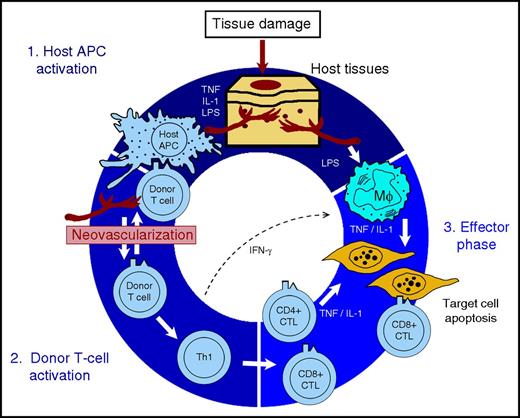In this issue of Blood, Riesner et al describe that neovascularization precedes infiltration of inflammatory cells in graft-versus-host disease (GVHD) and colitis models, revealing a new pathophysiological sequence of disease initiation.1
Pathomechanism of GVHD including neovascularization. APC, antigen-presenting cell; CTL, cytotoxic T lymphocyte; IFN, interferon; IL, interleukin; LPS, lipopolysaccharide; Mϕ, macrophage; Th1, T helper 1 cell; TNF, tumor necrosis factor. Modified and reprinted with permission from Elsevier (The Lancet, 2009, 373, 1550-1561).6
Pathomechanism of GVHD including neovascularization. APC, antigen-presenting cell; CTL, cytotoxic T lymphocyte; IFN, interferon; IL, interleukin; LPS, lipopolysaccharide; Mϕ, macrophage; Th1, T helper 1 cell; TNF, tumor necrosis factor. Modified and reprinted with permission from Elsevier (The Lancet, 2009, 373, 1550-1561).6
In Greek philosophy, the term kairos (καιρός) defines the perfect time point. With regard to therapeutic strategies and decisions in medicine, the determination of the καιρός is equally important as the identification of major mechanisms and pathways leading to substantiated understanding of (patho)physiological processes and to identification of potential therapeutic targets. In GVHD, development of novel treatment strategies is urgently needed because it remains the leading diagnostic and therapeutic challenge following allogeneic hematopoietic stem cell transplantation with the consequence of severe morbidity and nonrelapse mortality, especially when nonresponsive to high-dose steroid therapy.2 In recent years, evidence has emerged that the vascular endothelium could be a target structure for GVHD therapy because an association of the formation of new blood vessels and GVHD has been observed.3 Per se, the important role of neovascularization has long been established in GVHD, but the chronological sequence of the establishment of new vasculature and immune cell infiltration has remained unclear.3 Although it has been previously believed that angiogenesis would be stimulated by secreted mediators from tissue-infiltrating immune cells,4 Riesner and coworkers observed that the contrary is the case, showing that angiogenesis precedes the infiltration of immune cells into damaged tissues. Importantly, after incipient tissue damage, angiogenesis occurred as early as 2 days after allogeneic hematopoietic stem cell transplantation, indicating that the pathogenesis of GVHD is already commenced early with novel vasculature to tackle a route for immune cells. Their findings suggest a new chronological sequence of GVHD initiation (tissue damage, neovascularization, immune cell infiltration). These observations might help to improve our understanding of the underlying mechanisms of GVHD. Hence, this new evidence might help explain why GVHD primarily affects tissues that are more susceptible to infectious agents, why GVHD mainly manifests in distinct organs, and how GVHD-mediating T cells are primed and activated, shedding new light on immunobiology in general and GVHD T-cell biology in particular (see figure).
GVHD is believed to be mainly mediated by allogeneic T cells that recognize differences in tissue antigens, which are expressed on recipient cells. These are most importantly major histocompatibility complexes (MHCs, in humans termed HLAs) as a complex with their respective bound peptides.5 This direct recognition of peptide MHC is avoided by MHC-matched (or HLA-identical) transplantation. However, about 40% of patients who receive HLA-identical grafts will still develop GVHD, which can then be mediated by recognition of minor histocompatibility antigens.6 These constitute MHC-presented peptides representing protein fragments which are produced during normal cellular metabolism and exhibit amino acid sequence variants based on single-nucleotide polymorphisms between donor and recipient. Further recognition of peptides can also be based on specific sequence variants based on intrinsic alterations in leukemic cells, then mediating graft-versus-leukemia (GVL) effects.7 Of note, sole recognition of such antigen differences cannot be the only mechanism mediating GVHD or GVL because it has been observed that new autoimmunity (diseases sharing features with “naturally occurring” autoimmune diseases)8 and graft versus self (GVS; recognition of MHC-restricted autoepitopes)9 can develop, constituting that further processes must be involved in the genesis of graft-host interaction.
Based on the findings by Riesner et al, neovascularization could hereby be an important prerequisite for priming of naive T cells or for proliferation of tissue-specific memory T cells against alloantigens, autoantigens, and leukemia (or tumor) antigens. This is further underlined by the observation that endothelial cells can also upregulate MHC molecules and function as antigen-presenting cells to naive T cells in inflamed tissue.10 The data of Riesner and colleagues might in this context also support a further comprehension of in situ T-cell priming. Importantly, they used a chemotherapy-based MHC-matched system in chronological dependency, in contrast to previously used mouse models with MHC mismatch that were designed to induce maximal GVHD. This model could also be used for further studies of GVHD initiation with regard to danger signals, immune-regulatory molecules, and pathogen-associated molecular patterns more similar to transplantation in a human setting. This model could also guide the timing of future therapeutic approaches, as for prevention of T-cell priming by antiangiogenetic therapy, the καιρός for therapy initiation also has to be early. Naturally, a mismatch model could not mimic development of new autoimmunity or GVS.
In summary, the data of Riesner et al provide promising novel insights into the chronological development of inflammation in general and GVHD in particular. They show that neovascularization paves the way for infiltration of immune cells into damaged tissue and occurs very quickly after allogeneic hematopoietic stem cell transplantation, indicating that priming and antigen exposition of GVHD-mediating T cells also must be an early event in the cascade of GVHD development. These data will therefore contribute to better comprehension of inflammation initiation and T-cell priming in GVHD. As discussed extensively in their article, the translation of these observations into the clinic in order to improve therapeutic options for GVHD patients, without hampering GVL effects, requires further preclinical evaluation in animal models in order to identify the proper substances and the right καιρός.
Conflict-of-interest disclosure: The author declares no competing financial interests.


This feature is available to Subscribers Only
Sign In or Create an Account Close Modal